The
Australian Cattle Dog (ACD), or
simply Cattle Dog, is a breed of herding dog originally developed in Australia
for droving cattle over long distances across rough terrain. This breed is a
medium-sized, short-coated dog that occurs in two main colour forms. It has
either brown or black hair distributed fairly evenly through a white coat,
which gives the appearance of a "red" or "blue" dog.
As
with dogs from other working breeds, the Australian Cattle Dog is energetic and
intelligent with an independent streak. It responds well to structured
training, particularly if it is interesting and challenging. It was originally
bred to herd by biting, and is known to nip running children. It forms a strong
attachment to its owners, and can be protective of them and their possessions.
It is easy to groom and maintain, requiring little more than brushing during
the shedding period. The most common health problems are deafness and
progressive blindness (both hereditary conditions) and accidental injury;
otherwise, it is a robust breed with a lifespan of 12 to 14 years.
In
the 19th century, New South Wales cattle farmer Thomas Hall crossed the dogs
used by drovers in his parents' home county, Northumberland, with dingoes he
had tamed. The resulting dogs were known as Halls Heelers. After Hall's death
in 1870, the dogs became available beyond the Hall family and their associates.
They were subsequently developed into two modern breeds: the Australian Cattle
Dog and the Australian Stumpy Tail Cattle Dog. Robert Kaleski, who wrote the
first standard for the breed, was influential in its development.
Australian
Cattle Dog has been nicknamed a "Red Heeler" or "Blue
Heeler" on the basis of its colouring and practice of moving reluctant
cattle by nipping at their heels. Dogs from a line bred in Queensland,
Australia, which were successful at shows and at stud in the 1940s, were called
"Queensland Heelers" to differentiate them from lines bred in New
South Wales; this nickname is now occasionally applied to any Australian Cattle
Dog.
Characteristics
Appearance
The
Australian Cattle Dog is a sturdy, muscular, compact dog that gives the
impression of agility and strength. It has a broad skull that flattens to a
definite stop between the eyes, with muscular cheeks and a medium-length, deep,
powerful muzzle. The ears are pricked, small to medium in size and set wide
apart, with a covering of hair on the inside. The eyes are oval and dark, with
an alert, keen expression. The neck and shoulders are strong and muscular; the
forelegs are straight and parallel; and the feet round and arched, with small,
sturdy toes and nails.
The
Cattle Dog breed standard states that it should have well-conditioned muscles,
even when bred for companion or show purposes, and that its appearance should
be symmetrical and balanced, with no individual part of the dog exaggerated. It
should not look either delicate or cumbersome, as either characteristic limits
the agility and endurance that is necessary for a working dog.
Size
The
female Australian Cattle Dog measures approximately 43–48 centimetres (17–19
in) at the withers, and the male measures about 46–51 centimetres (18–20 in) at
the withers. The dog should be longer than tall, that is, the length of the
body from breast bone to buttocks is greater than the height at the withers, in
a ratio of 10 to 9. An Australian Cattle Dog in good condition weighs around
15–22 kilograms (33–49 lb).
Coat and colour
There
are two accepted coat colours, red and blue, though chocolate and cream do
occur. Blue dogs can be blue, blue mottled, or blue speckled with or without
black, tan, or white markings. Red dogs are evenly speckled with solid red
markings. Both red dogs and blue dogs are born white (except for any
solid-coloured body or face markings) and the red or black hairs grow in as
they mature. The distinctive adult colouration is the result of black or red
hairs closely interspersed through a predominantly white coat. This is not
merle colouration (a speckled effect that has associated health issues), but
rather the result of the ticking gene. A number of breeds show ticking, which
is the presence of colour through white areas, though the overall effect
depends on other genes that will modify the size, shape and density of the
ticking.
In
addition to the primary colouration, an Australian Cattle Dog displays some
patches of solid or near-solid colour. In both red and blue dogs, the most
common are masks over one or both eyes, a white tip to the tail, a solid spot
at the base of the tail, and sometimes solid spots on the body, though these
are not desirable in dogs bred for conformation shows. Blue dogs can have tan
midway up the legs and extending up the front to breast and throat, with tan on
jaws, and tan eyebrows. Both colour forms can have a white "star" on
the forehead called the "Bentley Mark", after a legendary dog owned
by Tom Bentley. Common miscolours in the Australian Cattle Dog are black hairs
in a red-coated dog, including the extreme of a black saddle on a red dog, and
extensive tan on the face and body on a blue dog, called "creeping
tan". The Cattle Dog has a double coat—the short, straight outer guard
hairs are protective in nature, keeping the elements from the dog's skin while
the undercoat is short, fine and dense.
The
mask consists of a black patch over one or both eyes (for the blue coat colour)
or a red patch over one or both eyes (for the red coat colour). Depending on
whether one or both eyes have a patch, these are called, respectively,
"single" (or "half") mask and "double" (or
"full") mask. Dogs without a mask are called plain-faced. Any of
these are acceptable according to the breed standard. In conformation shows,
even markings are preferred over uneven markings.
Tail
The
breed standards of the Australian, American and Canadian kennel clubs specify
that the Australian Cattle Dog should have a natural, long, un-docked tail.
There will often be a solid colour spot at the base of the tail and a white
tip. The tail should be set moderately low, following the slope of the back. It
should hang in a slight curve at rest, though an excited dog may carry its tail
higher. The tail should feature a reasonable level of brush.
In
the United States, tails are sometimes docked on working stock. The tail is not
docked in Australia, and serves a useful purpose in increasing agility and the
ability to turn quickly. The Australian Cattle Dog is a breed distinct from the
Australian Stumpy Tail Cattle Dog, a square-bodied dog born with a naturally
"bobbed" tail. The Stumpy Tail resembles the Australian Cattle Dog,
but has a taller, leaner conformation. It occasionally has a natural long thin
tail, but most are born without tails.
Temperament
Like
many working dogs, the Australian Cattle Dog has high energy levels, an active
mind, and a level of independence. The breed ranks 10th in Stanley Coren's The
Intelligence of Dogs, rated as one of the most intelligent dogs ranked by obedience
command trainability. The Cattle Dog needs plenty of exercise, companionship
and a job to do, so a non-working dog might participate in dog sports, learning
tricks, or other activities that engage its body and mind.
When
on home ground, the Australian Cattle Dog is an affectionate and playful pet.
However, it is reserved with people it does not know and naturally cautious in
new situations. Its attitude to strangers makes it an excellent guard dog when
trained for this task, and it can be socialised to become accustomed to a
variety of people from an early age as a family pet. It is good with older,
considerate children, but will herd people by nipping at their heels,
particularly younger children who run and squeal. By the time puppies are
weaned, they should have learned that the company of people is pleasurable, and
that responding to cues from a person is rewarding. The bond that this breed
can create with its owner is strong and will leave the dog feeling protective
towards the owner, typically resulting in the dog's never being too far from
the owner's side. The Australian Cattle Dog can be the friendliest of
companions although it is quick to respond to the emotions of its owners, and
may defend them without waiting for a command. The ACD was originally bred to
move reluctant cattle by biting, and it will bite if treated harshly. The
Australian Cattle Dog's protective nature and tendency to nip at heels can be
dangerous as the dog grows into an adult if unwanted behaviours are left
unchecked.
While
an Australian Cattle Dog generally works silently, it will bark in alarm or to
attract attention. It has a distinctive intense, high-pitched bark. Barking can
be a sign of boredom or frustration, although research has shown that pet dogs
increase their vocalisation when raised in a noisy environment. It responds
well to familiar dogs, but when multiple dogs are present, establishing a
pecking order can trigger aggression. It is not a breed that lives in a pack
with other dogs.
Data
accumulated from Council reports in New South Wales from April to June 2013,
showed that dogs identified as Australian Cattle Dogs were involved in 66
attacks, where an attack is defined as any incident where a dog rushes at,
bites, harasses or chases any person or animal. Staffordshire Bull Terrier (155
attacks), German Shepherd (89) and American Staffordshire Terrier (88) were
reported to be involved in more incidents. Expressed as a percentage of
registered dogs, 0.1% of Australian Cattle Dogs were involved in attacks. The
data gathered in 2011–2012 listed the ACD twenty-seventh in involvement in
incidents ranked by percentage of dogs registered. A review of incidents in Melbourne where a dog
bit, rushed at or chased a person or animal in a public space, found that there
were sixty breeds involved and the German Shepherd and German Shepherd crosses,
and Australian Cattle Dog and Cattle Dog crosses accounted for 9% of incidents.
Surveys of U.S. breed club members showed that both dog-directed aggression and
stranger-directed aggression were higher in the ACD than the average of breeds
studied, with dog-directed aggression being the more prevalent of the two
aggression types. The American Temperament Test Society reports a test pass
rate of 79.3% for Australian Cattle Dogs. The average pass rate for all breeds
is 80.4%.
Health and lifespan
Lifespan
In a
small sample of 11 deceased dogs, Australian Cattle Dogs had a median longevity
of 11.7 years (maximum 15.9 yrs). A larger survey of 100 deceased dogs yielded
a mean longevity of 13.41 years with a standard deviation of 2.36 years. The
median longevities of breeds of similar size are between 11 and 13 years. There
is an anecdotal report of a Cattle Dog named Bluey, born in 1910 and living for
29.5 years, but the record is unverified. Even if true, Bluey's record age
would have to be regarded more as an uncharacteristic exception than as an
indicator of common exceptional longevity for the entire breed. It remains,
however, that Australian Cattle Dogs generally age well and appear to live on
average almost a year longer than most dogs of other breeds in the same weight
class. Many members of the breed are still well and active at 12 or 14 years of
age, and some maintain their sight, hearing and even their teeth until their
final days.
Common health problems
The
Australian Cattle Dog carries recessive piebald alleles that produce white in
the coat and skin and are linked to congenital hereditary deafness, though it
is possible that there is a multi-gene cause for deafness in a dog with the
piebald pigment genes. Around 2.4% of Cattle Dogs in one study were found to be
deaf in both ears and 14.5% were deaf in at least one ear.
The
Australian Cattle Dog is one of the dog breeds affected by progressive retinal
atrophy. It has the most common form, progressive rod-cone degeneration (PRCD),
a condition that causes the rods and cones in the retina of the eye to
deteriorate later in life, resulting in blindness. PRCD is an autosomal
recessive trait and a dog can be a carrier of the affected gene without
developing the condition.
Hip
dysplasia is not common in the breed, although it occurs sufficiently often for
many breeders to have their breeding stock tested. The Cattle Dog has a number
of inherited conditions, but most of these are not common. Hereditary
polioencephalomyelopathy of the Australian Cattle Dog is a very rare condition
caused by an inherited biochemical defect. Dogs identified with the condition
were completely paralysed within their first year. Based on a sample of 69
still-living dogs, the most common health issues noted by owners were
musculoskeletal (spondylosis, elbow dysplasia, and arthritis) and reproductive
(pyometra, infertility, and false pregnancy), and blindness. A study of dogs
diagnosed at Veterinary Colleges in the United States and Canada over a
thirty-year period described fractures, lameness and cruciate ligament tears as
the most common conditions in the Australian Cattle Dogs treated.















